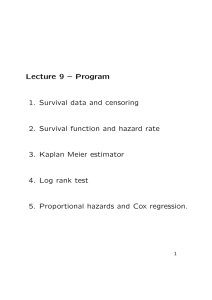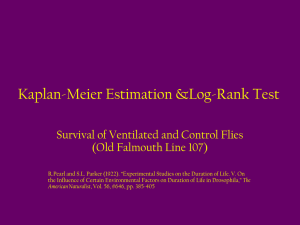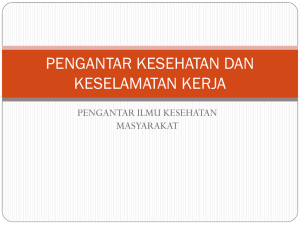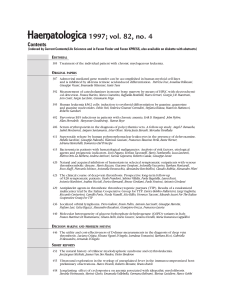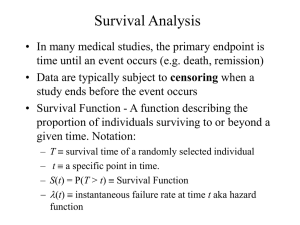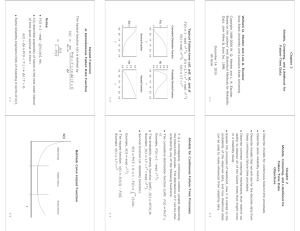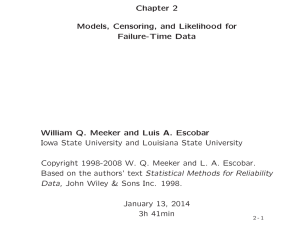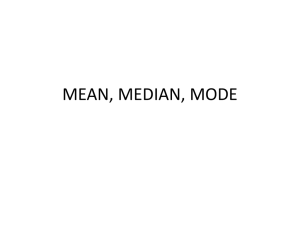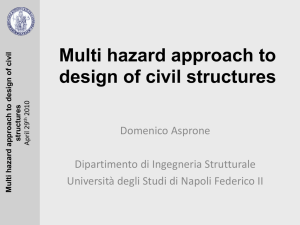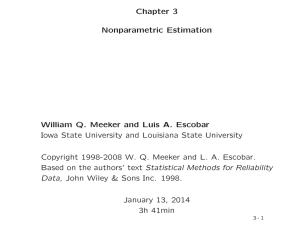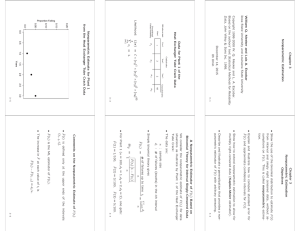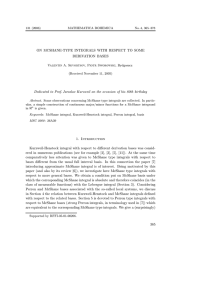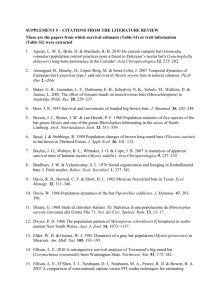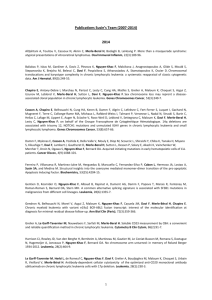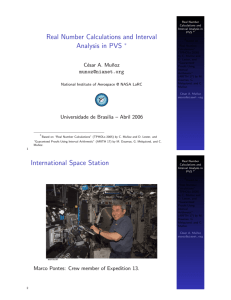Survival Analysis: Life Table Method
advertisement
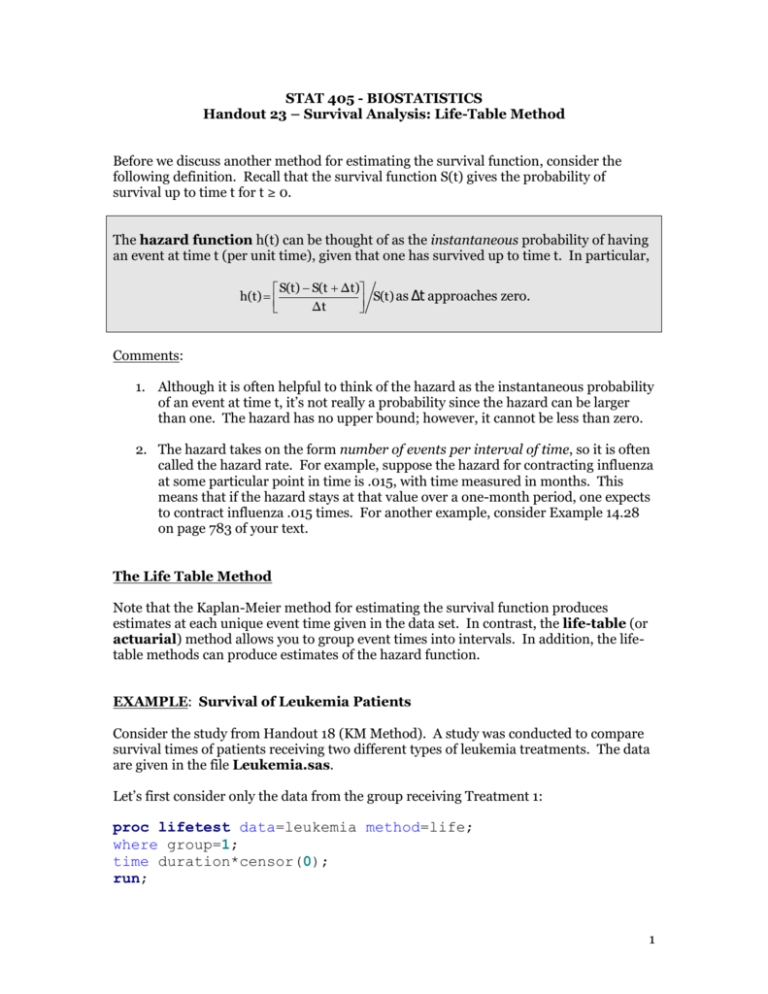
STAT 405 - BIOSTATISTICS Handout 23 – Survival Analysis: Life-Table Method Before we discuss another method for estimating the survival function, consider the following definition. Recall that the survival function S(t) gives the probability of survival up to time t for t ≥ 0. The hazard function h(t) can be thought of as the instantaneous probability of having an event at time t (per unit time), given that one has survived up to time t. In particular, S(t) S(t Δt) h(t) S(t) as Δt approaches zero. Δt Comments: 1. Although it is often helpful to think of the hazard as the instantaneous probability of an event at time t, it’s not really a probability since the hazard can be larger than one. The hazard has no upper bound; however, it cannot be less than zero. 2. The hazard takes on the form number of events per interval of time, so it is often called the hazard rate. For example, suppose the hazard for contracting influenza at some particular point in time is .015, with time measured in months. This means that if the hazard stays at that value over a one-month period, one expects to contract influenza .015 times. For another example, consider Example 14.28 on page 783 of your text. The Life Table Method Note that the Kaplan-Meier method for estimating the survival function produces estimates at each unique event time given in the data set. In contrast, the life-table (or actuarial) method allows you to group event times into intervals. In addition, the lifetable methods can produce estimates of the hazard function. EXAMPLE: Survival of Leukemia Patients Consider the study from Handout 18 (KM Method). A study was conducted to compare survival times of patients receiving two different types of leukemia treatments. The data are given in the file Leukemia.sas. Let’s first consider only the data from the group receiving Treatment 1: proc lifetest data=leukemia method=life; where group=1; time duration*censor(0); run; 1 The following output shows the results: PROC LIFETEST constructs eight intervals, starting at 0 and incrementing by periods of 5 months. The procedure uses an algorithm for the default choice of intervals. To override this default, you can use the “INTERVALS = …” option in the PROC LIFETEST statement to specify the cut-off points. For example, consider the following. proc lifetest data=leukemia method=life intervals = 10 20 30 40; where group=1; time duration*censor(0); run; 2 Let’s consider the default output (with eight intervals). Recall that for the 21 patients who received Treatment 1, the survival times of the patients are given as follows: 6, 6, 6, 6+, 7, 9+, 10, 10+, 11+, 13, 16, 17+, 19+, 20+, 22, 23, 25+, 32+, 32+, 34+, 35+ A fundamental property of the life-table method is that any cases censored within an interval are treated as if they were censored at the midpoint of the interval. So, since censored cases are at risk for only half of the interval, they count for only half in figuring the number at risk. The life-table method is then used as follows to estimate the survival function for Treatment Group 1. Interval # at risk # of events # censored Estimated Probability of Surviving (beyond the start of the interval) Estimated Survivor Function Ŝ(t) 1 q j 1 q j [0,5) [5,10) [10,15) [15,20) [20,25) [25,30) [30,35) [35,40) 3 Verify the results for the output with four intervals: Interval # at risk # of events # censored Estimated Probability of Surviving (beyond the start of the interval) Estimated Survivor Function Ŝ(t) 1 q j 1 q j [0,10) [10,20) [20,30) [30,40) We will also consider a few other columns from the output: The standard errors of the survival probabilities can be used to construct confidence intervals around the survival probabilities for each interval. The Hazard column gives estimates of the hazard function at the midpoint of each interval. This is calculated as h(t i m ) di w d b i n i i i 2 2 where for the ith interval, tim is the midpoint, di is the number of events, bi is the width of the interval, ni is the number still at risk at the beginning of the interval, and wi is the number of censored cases within the interval. 4 Questions: 1. Verify that the hazard estimate is 4.44% for the second interval. 2. Interpret the hazard estimate from question 1. You can plot the survival and hazard estimates by putting PLOTS=(S,H) in the PROC LIFETEST statement: proc lifetest data=leukemia method=life plots=(s, h); where group=1; time duration*censor(0); run; 5 Questions: 1. Why is the hazard function zero for the last three intervals? Finally, note that you can request confidence intervals on the plots. The following code requests tests for a difference in Treatments. Also, it requests estimates and plots of both the survivor and hazard functions for both Treatments 1 and 2. ods html; ods graphics on; proc lifetest data=leukemia method=life plots=survival(cl cb=hw strata=panel) plots=hazard(cl) ; time duration*censor(0); strata group; symbol1 v=none; symbol2 v=none; run; ods graphics off; ods html close; 6 7

